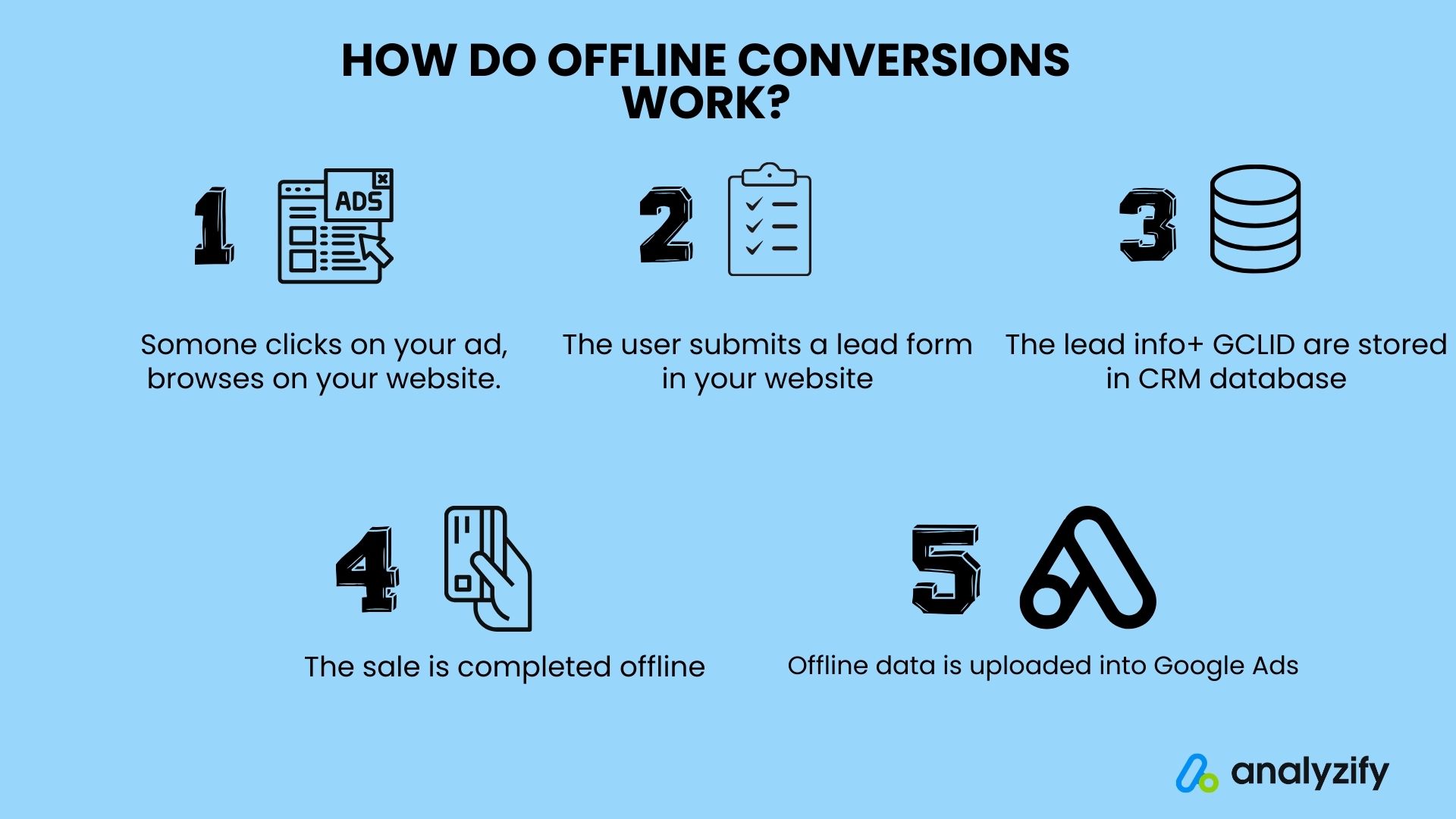Imagine this: a customer sees your ad, clicks on it, but then decides to make a purchase offline by giving you a call.
But here’s the question – how can you keep track of such conversions that happen outside your website?
While many people concentrate solely on online conversion tracking, there’s a crucial aspect that often gets overlooked – tracking offline conversions.
It’s an essential element for shaping a well-rounded marketing strategy that encompasses all types of conversions and reaches various audiences.
Key takeaways:
- Offline Conversions Defined: Offline conversions refer to real-world actions resulting from online marketing efforts, such as in-store purchases and phone inquiries.
- Bridge Online and Offline Data: Offline conversion tracking allows you to attribute online efforts to offline interactions. It’s vital for businesses with significant physical interactions.
- Diverse Offline Conversions: Offline conversion tracking encompasses a wide array of actions, including in-store purchases, face-to-face sales, phone inquiries, and leads generated offline.

What Are Offline Conversions and How to Track Them?
Simply put, offline conversions are when your desired outcomes as a business happen in the offline world. This could be an in-store purchase or an enrollment through a physical form rather than an online one.
The main idea is that the transaction gets finalized in the real world instead of the virtual.
Let’s explain offline conversions with a scenario:
-
- Imagine you own a trendy shoe store known for its unique footwear collection. A customer named Emily comes across your store’s ad on a fashion blog she follows.
- The ad showcases a limited-edition pair of sneakers that catches Emily’s attention. Intrigued by the design, she decides to explore further.
In this context:
- Desired Outcome in the Offline World: Emily’s desired outcome, purchasing the limited-edition sneakers, takes place offline. This represents an offline conversion.
- Offline Transaction Finalization: After viewing the online ad, Emily visits your physical store to try on the sneakers. She falls in love with the fit and style and decides to buy them. The transaction is completed in-store, marking an offline conversion.
- Offline Conversion Types: Emily’s action falls under the category of “in-store purchase.” While her initial interest was sparked by the online ad, her final decision and purchase took place during her in-store visit.
This scenario highlights the concept of offline conversions as Emily’s journey starts with online engagement but evolves into an in-person interaction culminating in a purchase, exemplifying the transition from virtual engagement to real-world transaction.
What Tools Are Required to Track Offline Conversions?
To track offline conversions, you need essential tools. These include a Google Ads account (or similar campaign platform) for linking ad clicks to offline conversions, a Google Analytics account for data gathering and analysis, and a Customer Relationship Management (CRM) tool to centralize leads and customer data.
Are Additional Tools Necessary? Depending on how customers primarily connect with your business, you might require additional tools like call tracking software for phone-based transactions. Starting with the fundamental tools is crucial as they form the foundation for comprehensive offline conversion tracking.
What Is the Purpose of Offline Conversion Tracking?
Two words: more data! This may not come as a surprise in today’s data-driven world, but when you come to think of it, knowledge is power. Identifying your customer demographics and frequent sales channels is key to a fool-proof marketing strategy, and you can’t exactly expect to have this if you are missing a chunk of your sales data.
Think of it this way: You may be making sales largely through your online store, but there are customers who still come to buy directly from your physical store.
- Why did they decide to buy from you?
- Could it be an ad they saw while searching for their options, or a friend of theirs who recommended your brand?
Offline conversion tracking is the answer to all these questions.

What Are the Benefits of Offline Conversion Tracking?
The greatest benefit of offline conversion tracking boils down to the fact that it enables a comprehensive approach to ad optimization. But what exactly do we mean by “comprehensive”?
Real-World Customer Behavior: Imagine you manage a business with a high occurrence of in-store purchases. If you disregard offline conversions, you risk losing out on a significant chunk of valuable customer data.
Inclusive Data Collection: Through offline conversion tracking, you get the opportunity to encompass this often overlooked subset of customers into your database. By understanding what triggered their conversion, you gain insights to refine your ad targeting strategies.
Enhanced Results: Leveraging this data helps enhance ad outcomes across various metrics, such as revenue and interaction rate. By refining your targeting, your ads can yield improved results.
Better Sales Tracking: The benefits extend to more precise sales tracking. This means understanding the broader impact of your ads, encompassing both online and offline transactions.
Holistic Ad Optimization: Armed with insights into offline conversions, your ad optimization process becomes more holistic. You’ll have a clearer understanding of how your ads perform beyond the digital realm.
What Is Offline Conversion Import?
You’ve gathered the data, but what’s the use if you can’t analyze it to make concrete decisions?
In this case, the data you’ve gathered in your CRM software is only useful if it’s imported to the ad campaign tool you use, so that the ad can be matched with the customer info. This tool could be Google Ads, Facebook, Linkedin, etc. but for now, our main focus will be on Google Ads.
By importing the offline conversion data you’ve gathered in your CRM software to Google Ads, you will be able to match the customer information with the ad they’ve clicked on.
Cross-Channel Impact: Even if customers convert offline, the imported data in Google Ads ensures that their offline conversion is tied back to the ad they engaged with. This provides valuable insights into the impact of your ads on offline conversions.
Lead Generation and Attribution: Through this integration, you gain insight into which ads influenced customers’ offline decisions. This attribution helps you understand the role your ads played in driving conversions, both online and offline.
How to Set Up Offline Conversion Tracking in Google Ads?
Setting up offline conversions in Google Ads involves a few key steps:
- Integrate GCLID with CRM: Ensure that the Google Click ID (GCLID) is used alongside a CRM tool. This allows for matching unique IDs with customer details. You may need to make adjustments to your website’s code to include GCLID as a special parameter.
- Custom Fields in CRM: Decide which conversions you want to track. Create custom fields in your CRM for these conversions. For instance, if your target conversion is a form submission, set up a custom field for this action.
- Link GCLID with Conversions: Whenever a customer completes a conversion action, associate their unique GCLID with it in your CRM. This ensures you can later retrieve and link this information to the customer when an offline conversion occurs.
While this may sound complex, it primarily involves becoming familiar with the interfaces of both Google Ads and your chosen CRM tool.
For precise steps on enabling offline conversion tracking in your Google Ads account, refer to more detailed guidance on how to set up offline conversions in Google Ads.
How to Track Offline Conversions with Google Ads?
Tracking offline conversions with Google Ads involves two key components: the Google Click ID (GCLID) and a CRM tool. Here’s how they work together:
GCLID Activation: When a customer clicks on your ad, a special parameter known as the GCLID is activated within your ad’s URL.
Data Matching: As the customer explores your site, they may fill out a form. The information provided is then linked to this unique GCLID.
CRM Database Storage: Both the customer’s information and the GCLID are stored in your CRM database for potential offline matching in the future.
Offline Conversion Extraction: When an offline conversion occurs, it’s identified and sent to Google Ads through CRM integration.
For further details on tracking offline conversions with Google Ads, you can refer to Google’s own handbook.
Conclusions
You should always keep in mind that no marketing strategy is complete if you leave a part of your data out of the equation. Implementing offline conversion tracking to your ads strategy is a great way to create campaigns that are both diverse and comprehensive.
By hooking up a few tools, you can attribute offline data to your ad campaigns and reinforce your conversions, and even have the chance to find out audiences you previously thought were not actually interested in your business.
Offline conversions also provide great insight when you need to come up with new ways to reach out to your existing audiences.
Don’t forget that the goal of a truly great ad should be to exist beyond the brief moment your audience interacts with it, and tracking your offline conversions could be the golden proof that this is the case. So in short, we advise that you don’t miss out on this amazing tool and, who knows, you may even be surprised to find out information you never knew existed.

































